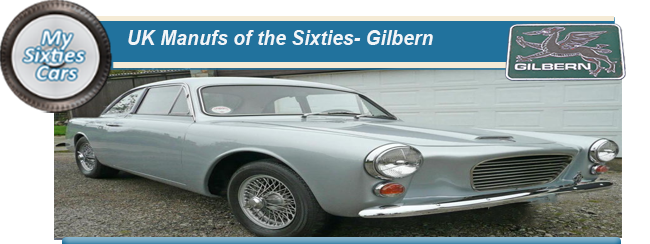
Gilbern Motors was a Welsh sports car manufacturer that was active from 1959 to 1973. The company was founded by Giles Smith and Bernard Friese, a German former POW who had remained in the UK after he married an English girl after the war.
Friese made his home in South Wales during the late Fifties, moving to the picturesque setting of Plantwide Fardre, near Pontypridd in South Wales.
in search of work during the Fifties.
 It was there that he struck up a friendship with Giles Smith, who ran a butcher’s shop in the village. Their friendship was based around their mutual interest in cars and their production.
It was there that he struck up a friendship with Giles Smith, who ran a butcher’s shop in the village. Their friendship was based around their mutual interest in cars and their production.
Friese, a big believer in the benefits of glass fibre, convinced Smith to work with him on a project, to produce a car to be paid for and later used by Smith.
Bernard came to the table with considerable practical experience, having spent some years working as a coachbuilder with a small company who specialised in working with glass fibre.
As the car was nearing completion, an acquaintance of Smith by the name of Peter Cottrell paid a visit to the duo’s workshop, situated in a shed behind the butcher shop. to appraise progress.
Cottrell was more than impressed by the quality of the work, going as far as persuading Smith and Friese that the car they were working on had commercial possibilities.
 Excited by the prospect, Smith and Friese decided to combine their names and their talents to create the brand name "Gilbern", with the GT being their first model, establishing their manufacturing facilities in the town
Excited by the prospect, Smith and Friese decided to combine their names and their talents to create the brand name "Gilbern", with the GT being their first model, establishing their manufacturing facilities in the town
 The site chosen was a former colliery that had been derelict for more than forty years, adjacent to the town’s railway station. The site was purchased thanks to a loan of from Giles Smith father.
The site chosen was a former colliery that had been derelict for more than forty years, adjacent to the town’s railway station. The site was purchased thanks to a loan of from Giles Smith father.
Production at Gilbern got underway in1961. The company almost immediately began to encounter problems, caused largely by their lack of working capital, meaning that most of their major component, in particular engines and gearboxes needing to buy in small quantities with no attendant discounts.
![]()
The attraction in purchasing a car in component form was the considerable saving in purchase tax and excise duties, which could be as high as 45%,
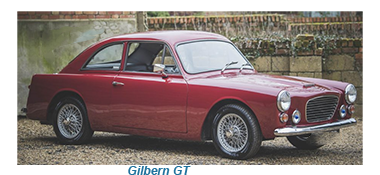 The GT mechanics were drawn from Austin, in particular the A35, hardly the fastest cars on UK roads at that time. The advantage of buying a Gilbern that any powertrain that fitted the chassis could be fitted, a factor that greatly affected sales in Gilbern’s later models, the Genie and Invader.
The GT mechanics were drawn from Austin, in particular the A35, hardly the fastest cars on UK roads at that time. The advantage of buying a Gilbern that any powertrain that fitted the chassis could be fitted, a factor that greatly affected sales in Gilbern’s later models, the Genie and Invader. 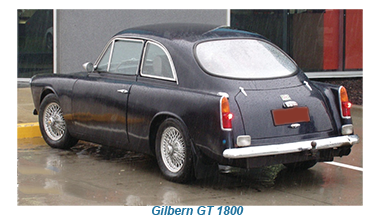 These models were often fitted with inline-four and inline-six engines.
These models were often fitted with inline-four and inline-six engines.
During the early Sixties, sales were pottering along at just a month, Gilbern employed a staff of just five with, both Bernard and Giles taking their part in producing the cars, running the business while Giles also kept his eye on the butcher’s shop.
Little changes were made to the GT. If they were they were cosmetic, such as fitting wire wheels and adding rear trailing arm suspension at the rear.
In 1961 Gilbern began to fit their GT with an 1800 engine, upgrading it to become the 1800GT.
During 1966, with production capability gradually increasing, Smith and Friese decided that the time was right to introduce a new model, which they named the Genie.
Compared to the GT, the Genie was a much larger and roomier car, a 2+2 Grand Tourer fitted with a V6 engine from Ford UK. Essex and a highly distinctive body style.
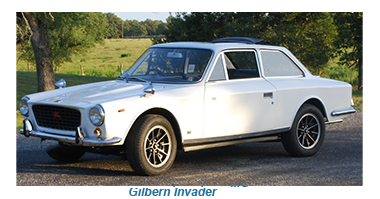 This situation combined to affect the selling prices of their cars or their profitability- or a mixture of both.
This situation combined to affect the selling prices of their cars or their profitability- or a mixture of both.
Unlike many of their competitors in the sports car sector, the early Gilberns were always classed as producers of “component cars” instead of “kit cars” This meant that vehicles were always supplied in an almost finished form. With a full paintjob, auto electric system, and exterior and interior trims. Buyers were responsible for the fitting of engine, gearbox and exhaust.
![]()
In the summer of 1969 ACE brought in a new model, the Invader to replace the Genie , From the outside the two models were virtually identical , but the chassis was upgraded considerably, while minor changes were made to the bodywork and interior.
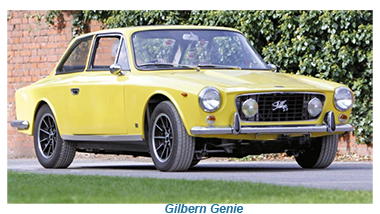 The Invader failed to capture the imagination of the motoring press, with several problems beginning to arise, most the alarmingly cracks that had begun to appear in the chassis.
The Invader failed to capture the imagination of the motoring press, with several problems beginning to arise, most the alarmingly cracks that had begun to appear in the chassis.
Sales, although improving, were way below ACE’s expectations, reaching a peak of just 200 a year in 1972.
Seeing the writing on the wall, Gilbern Motors wound down production in 1973 and the company disappeared without trace.
Despite their unhappy ending, there remain a loyal group of Gilbern followers to this day, a select few of whom even own one of the one thousand plus vehicles produced during the company’s fifteen years production run.





